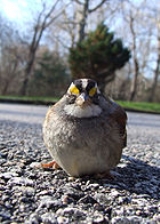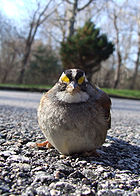
White-throated Sparrow
Encyclopedia
The White-throated Sparrow (Zonotrichia albicollis) is a passerine
bird
of the American sparrow
family Emberizidae
.
 The White-throated Sparrow is a passerine
The White-throated Sparrow is a passerine
bird
of the American sparrow
family Emberizidae
. The White-throated Sparrow is 17 cm (6.75 inches) in length with a wingspan of 23 cm (9 inches) Typical weight is 26 grams (0.91 oz).
There are two adult plumage variations known as the tan-striped and white-striped forms. On the white-striped form the crown is black with a white central stripe. The supercilium is white as well. The auriculars are gray with the upper edge forming a black eye line.
On the tan form, the crown is dark brown with a tan central stripe. The supercilium is tan as well. The auriculars are gray/light brown with the upper edge forming a brown eye line. Both variations feature dark eyes, a white throat, yellow lores and gray bill. There is variation and some individuals may show dark lateral stripes of each side of the throat.
They almost always pair with the opposite color morph for breeding. The two color morphs occur in approximately equal numbers. Both male and female white-striped birds are more aggressive than tan-striped birds during the breeding season.
The breast has gray/tan streaks and the streaks continue down the flanks but the belly is generally light gray. The wings are rufous with two distinct white wing bars. Sexes are morphologically similar.
and New England
. They nest either on the ground under shrubs or low in trees in deciduous or mixed forest areas and lay 3-5 brown-marked blue or green-white eggs.
to the southern and eastern USA
. It stays year round in the atlantic provinces of Canada. This bird is a rare vagrant
to western Europe
.
of "Po-or Sam Peabody, Peabody, Peabody" (or "O-oh sweet Canada, Canada, Canada") The rhythm is very regular, and the timbre could be described as pinched. These musical intervals are only approximate; to a human ear the song often sounds out of tune. The repeated note will often change in pitch very slightly, contributing to this effect.
The White-throated Sparrow also has at least two calls, in addition to its song.
Passerine
A passerine is a bird of the order Passeriformes, which includes more than half of all bird species. Sometimes known as perching birds or, less accurately, as songbirds, the passerines form one of the most diverse terrestrial vertebrate orders: with over 5,000 identified species, it has roughly...
bird
Bird
Birds are feathered, winged, bipedal, endothermic , egg-laying, vertebrate animals. Around 10,000 living species and 188 families makes them the most speciose class of tetrapod vertebrates. They inhabit ecosystems across the globe, from the Arctic to the Antarctic. Extant birds range in size from...
of the American sparrow
American sparrow
American sparrows are a group of mainly New World passerine birds, forming part of the family Emberizidae. American sparrows are seed-eating birds with conical bills, brown or gray in color, and many species have distinctive head patterns....
family Emberizidae
Emberizidae
The Emberizidae are a large family of passerine birds. They are seed-eating birds with a distinctively shaped bill.In Europe, most species are called buntings. In North America, most of the species in this family are known as sparrows, but these birds are not closely related to the sparrows, the...
.
Description

Passerine
A passerine is a bird of the order Passeriformes, which includes more than half of all bird species. Sometimes known as perching birds or, less accurately, as songbirds, the passerines form one of the most diverse terrestrial vertebrate orders: with over 5,000 identified species, it has roughly...
bird
Bird
Birds are feathered, winged, bipedal, endothermic , egg-laying, vertebrate animals. Around 10,000 living species and 188 families makes them the most speciose class of tetrapod vertebrates. They inhabit ecosystems across the globe, from the Arctic to the Antarctic. Extant birds range in size from...
of the American sparrow
American sparrow
American sparrows are a group of mainly New World passerine birds, forming part of the family Emberizidae. American sparrows are seed-eating birds with conical bills, brown or gray in color, and many species have distinctive head patterns....
family Emberizidae
Emberizidae
The Emberizidae are a large family of passerine birds. They are seed-eating birds with a distinctively shaped bill.In Europe, most species are called buntings. In North America, most of the species in this family are known as sparrows, but these birds are not closely related to the sparrows, the...
. The White-throated Sparrow is 17 cm (6.75 inches) in length with a wingspan of 23 cm (9 inches) Typical weight is 26 grams (0.91 oz).
There are two adult plumage variations known as the tan-striped and white-striped forms. On the white-striped form the crown is black with a white central stripe. The supercilium is white as well. The auriculars are gray with the upper edge forming a black eye line.
On the tan form, the crown is dark brown with a tan central stripe. The supercilium is tan as well. The auriculars are gray/light brown with the upper edge forming a brown eye line. Both variations feature dark eyes, a white throat, yellow lores and gray bill. There is variation and some individuals may show dark lateral stripes of each side of the throat.
They almost always pair with the opposite color morph for breeding. The two color morphs occur in approximately equal numbers. Both male and female white-striped birds are more aggressive than tan-striped birds during the breeding season.
The breast has gray/tan streaks and the streaks continue down the flanks but the belly is generally light gray. The wings are rufous with two distinct white wing bars. Sexes are morphologically similar.
Reproduction
White-throated Sparrows breed in central CanadaCanada
Canada is a North American country consisting of ten provinces and three territories. Located in the northern part of the continent, it extends from the Atlantic Ocean in the east to the Pacific Ocean in the west, and northward into the Arctic Ocean...
and New England
New England
New England is a region in the northeastern corner of the United States consisting of the six states of Maine, New Hampshire, Vermont, Massachusetts, Rhode Island, and Connecticut...
. They nest either on the ground under shrubs or low in trees in deciduous or mixed forest areas and lay 3-5 brown-marked blue or green-white eggs.
Wintering and Migration
In winter, it migratesBird migration
Bird migration is the regular seasonal journey undertaken by many species of birds. Bird movements include those made in response to changes in food availability, habitat or weather. Sometimes, journeys are not termed "true migration" because they are irregular or in only one direction...
to the southern and eastern USA
United States
The United States of America is a federal constitutional republic comprising fifty states and a federal district...
. It stays year round in the atlantic provinces of Canada. This bird is a rare vagrant
Vagrancy (biology)
Vagrancy is a phenomenon in biology whereby individual animals appear well outside their normal range; individual animals which exhibit vagrancy are known as vagrants. The term accidental is sometimes also used...
to western Europe
Europe
Europe is, by convention, one of the world's seven continents. Comprising the westernmost peninsula of Eurasia, Europe is generally 'divided' from Asia to its east by the watershed divides of the Ural and Caucasus Mountains, the Ural River, the Caspian and Black Seas, and the waterways connecting...
.
Diet
These birds forage on the ground under or near thickets or in low vegetation. They mainly eat seeds, insects and berries, and are attracted to bird feeders.Song and calls
There are at least two distinct songs sung by this species. One consists of an initial note, followed by three or so repeated notes at an interval of about a major third above. The second song consists of an initial note, a second a whole step lower, and a third note, repeated 2-3 times, about a minor third below that. This second song is commonly described by use of mnemonics with the cadenceCadence (music)
In Western musical theory, a cadence is, "a melodic or harmonic configuration that creates a sense of repose or resolution [finality or pause]." A harmonic cadence is a progression of two chords that concludes a phrase, section, or piece of music...
of "Po-or Sam Peabody, Peabody, Peabody" (or "O-oh sweet Canada, Canada, Canada") The rhythm is very regular, and the timbre could be described as pinched. These musical intervals are only approximate; to a human ear the song often sounds out of tune. The repeated note will often change in pitch very slightly, contributing to this effect.
The White-throated Sparrow also has at least two calls, in addition to its song.
External links
- White-throated Sparrow - Smithsonian Migratory Bird Center
- White-throated Sparrow Species Account - Cornell Lab of Ornithology
- White-throated Sparrow - Zonotrichia albicollis - USGS Patuxent Bird Identification InfoCenter
- White-throated Sparrow Information and Photos - South Dakota Birds and Birding
- Stamps
- White-throated Sparrow videos on the Internet Bird Collection
- White-throated Sparrow, Birds of Nova Scotia

